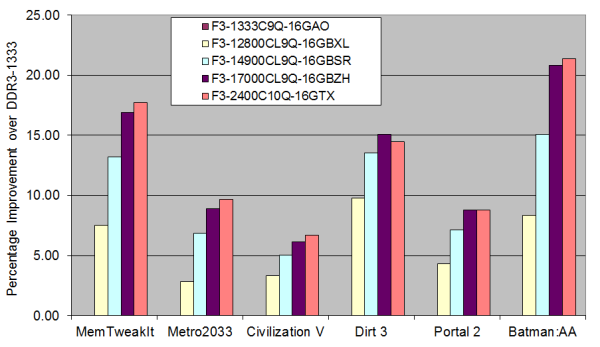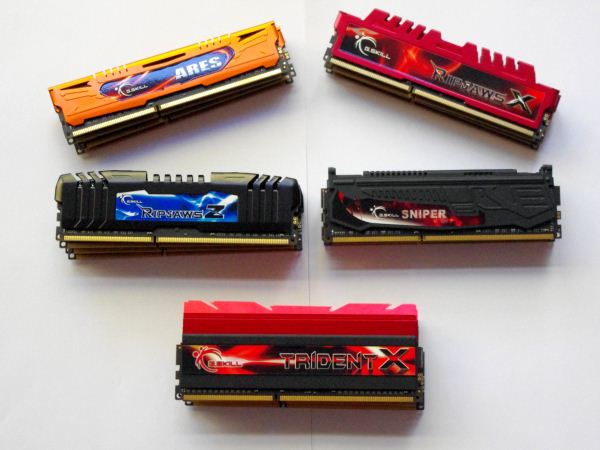Memory Performance: 16GB DDR3-1333 to DDR3-2400 on Ivy Bridge IGP with G.Skill
by Ian Cutress on October 18, 2012 12:00 PM EST- Posted in
- Memory
- G.Skill
- Ivy Bridge
- DDR3
I remember buying my first memory kit ever. It was a 4GB kit of OCZ DDR2 for my brand new E6400 system, and at the time I paid ~$240, sometime back in 2005. Skip forward seven years and users can enjoy four times as much density for under 1/3 of the price, an upswing by a factor 12x in terms of density against price. However in terms of the memory landscape, performance is a key factor when deciding between kits that cost almost the same, and making sure if that extra $15 for the next memory kit up is worth the jump.
The pricing for each of the kits are as follows:
$75: Ares DDR3-1333 9-9-9 4x4 GB
$80: RipjawsX DDR3-1600 9-9-9 4x4 GB
$95: Sniper DDR3-1866 9-10-9 4x4 GB
$130: RipjawsZ DDR3-2133 9-11-10 4x4 GB
$145: TridentX DDR3-2400 10-12-12 4x4 GB
Ultimately the best way to look at these results is through the IGP comparison graph posted several pages back:
Our synthetic test shows that as memory kits get faster, sub-timings can start to suffer (as in the kits we have tested), and as a result despite the extra MHz we can hit the law of limiting returns. If we tested a 2400 9-9-9 kit, I’m sure the synthetic test would rise proportionately as the jump from 1333 9-9-9 to 1600 9-9-9 and 1866 9-10-9 did. But it is the other results showing the kit comparison that makes interesting reading.
Ultimately whether a kit will be beneficial or not is down to the scenario in which it is used. All the tests today rely on having one part of the system at full stretch for a certain amount of time – either the CPU or the GPU. In most circumstances a system is not taxed, such as checking email or browsing the web, and thus memory may not make much of a difference (and it is hard to quantify in any scientific way). However, for situations where something is taxed, we can compare results.
As we see with our IGP testing, some games get boosted significantly with memory (Batman:AA), whereas some level out and get sub-10% boosts despite almost double the cost for that memory (Portal 2). In a similar fashion, our x264 decoding tests show that a small gain can be had, or in WinRAR up to 20% better performance is possible.
Writing this review has taken a lot longer than expected. Initially it comes down to what benchmarks should be run – there are a lot of synthetic results out in the wild from many sources, and I wanted to focus on real-world scenarios to aid buying decisions. Hopefully I have found a good number of different scenarios where buying that higher rated memory kit actually makes a difference – IGP gaming is the key one often quoted, but other options such as Maya, WinRAR compression and USB 3.0 throughput can be important too.
In the end, we have to recommend what kits our users should be looking for. Taking the DDR3-1333 C9 kit as a base, it seems a no-brainer to go for the DDR3-1600 C9 kit for $5 more. The boost across the board for a negligible difference in price is worth it. The jump up to the G.Skill 1866 C9 kit also provides enough of a measurable boost, although the leap in price from 1600 C9 is another $15, which could be harder to swallow.
As we move into the 2133 C9 kit we tested today, we again across our test bed see a tangible jump in performance. This jump is not as much as moving from 1333 to 1600, but it is there and users wanting peak performance will be happy with this kit, though the size of the user pockets will also have to match.
When it comes to our 2400 C10 kit results, compared to the 2133 C9, it is highly dependant which kit comes out on top. Even if one kit beats the other, it is only by a small margin – not one that can be justified by a $15 jump in the price.
For the majority of users, the DDR3-1866 C9 kit from G.Skill is a great buy, as long as the user remembers to enable XMP(!). Budget conscious builds will find solace in the DDR3-1600 C9 kit, which is a no brainer over the 1333 C9 kit for the extra $5. If your pockets are a little deeper, then the G.Skill DDR3-2133 C9 kit will offer some extra performance, but not as much as jumping between the other kits will. The DDR3-2400 C10 kit is not in the right ballpark compared to the other kits and only serves well for forum signatures. To sum up:
$75: Ares DDR3-1333 9-9-9 4x4 GB
$80: RipjawsX DDR3-1600 9-9-9 4x4 GB – Recommended for Budget Conscious
$95: Sniper DDR3-1866 9-10-9 4x4 GB – Recommended
$130: RipjawsZ DDR3-2133 9-11-10 4x4 GB – Recommended for Deeper Pockets
$145: TridentX DDR3-2400 10-12-12 4x4 GB – Not Recommended












114 Comments
View All Comments
crackedwiseman - Thursday, October 18, 2012 - link
OK, just one question: why in the hell are the IGP memory tests done on an i7? The results would be much more meaningful if the tests were on an AMD A10 or similar - it has a beefier IGP, and thus would be more bandwidth-bound.creed3020 - Thursday, October 18, 2012 - link
100% Agree. Doing these tests against a Trinity APU would have been much more interesting from a iGPU point of view. It it well known that AMD APUs benefit from increased memory bandwidth, AT has yet to test Trinity for this yet they did it for Llano.silverblue - Thursday, October 18, 2012 - link
It makes sense to test; HD 4000 is far superior to HD 3000 and it is worth knowing if that extra power is bandwidth limited. Generally, it is a little, though nowhere near as much as AMD's equivalents are.JonnyDough - Monday, October 22, 2012 - link
Not to mention, it's surprising to me that AMD wasn't mentioned as a company trying to match memory to motherboard. AMD started making their own memory modules, an interesting fact I think.SeanJ76 - Saturday, June 21, 2014 - link
AMD is a decade behind Intel, in processor technology and instructions, it really doesn't matter what AMD attempts to do....SeanJ76 - Saturday, June 21, 2014 - link
No one gives a shit about APU you moron......these are desktop tests!hp79 - Thursday, October 18, 2012 - link
Maybe because more people use intel? I agree that it would have stood out more if it was AMD's IGP, but doing the test on intel IGP is also okay and gives an idea of what to expect. I think the article is fine. Besides, do people really play games with IGP? If I am playing demanding games, I want the frame rates to be minimum 60 fps. That's why I use a dedicated graphics card. This might change when AMD's IGP gets even more powerful, but for now I think it's still not there yet.zcat - Thursday, October 18, 2012 - link
> Besides, do people really play games with IGP?Some of us do. My miniitx i7 is primarily for work & everyday use, but its HD4000 is fast enough for Portal 2 and Diablo 3 to be very playable @ 1920x1080p with AA off.
However, I know the limits of IGP, and intend on upgrading to an overclocked GeForce GTX 650 Ti very soon in order to play some more demanding games this winter.
sking.tech - Monday, October 22, 2012 - link
you may want to reconsider your choice of video "upgrade"nvidia's 2nd number is more significant than the first as far as overall gaming graphics power goes... You'd do better going for a 560 TI than a 650 for approx the same cost
Dirk Broer - Wednesday, July 24, 2013 - link
You should first look at what chip actually powers the card -and it's capabilities- before staring yourself blind on the last two digits. Besides that, a GTX 560 Ti is more expensive than a GTX 650.